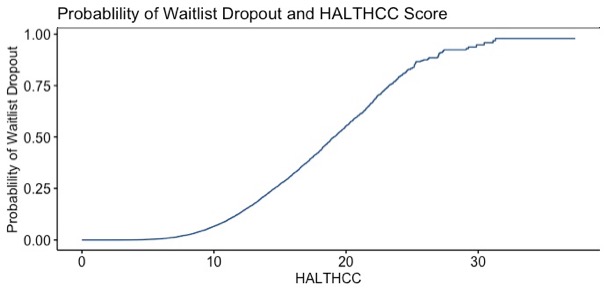Halt-hcc At The Time Of Listing Is Superior To Other Allocation Metrics At Predicting Waitlist Dropout; An Srtr Analysis
1Digestive Disease and Surgery Institute, Cleveland Clinic, Cleveland, OH, 2Department of General Surgery, Duke University, Durham, NC
Meeting: 2019 American Transplant Congress
Abstract number: 568
Keywords: Allocation, Hepatocellular carcinoma
Session Information
Session Name: Concurrent Session: Liver: Recipient Selection
Session Type: Concurrent Session
Date: Tuesday, June 4, 2019
Session Time: 4:30pm-6:00pm
 Presentation Time: 5:18pm-5:30pm
Presentation Time: 5:18pm-5:30pm
Location: Room 312
*Purpose: A recently developed liver allocation metric, Hazard Associated with Liver Transplant for Hepatocellular Carcinoma (HALT-HCC), has been shown to predict post-transplantation survival and recurrence. On the waitlist, peri-LRT change in HALT-HCC also predicts waitlist dropout but there has been no investigation at the time of listing. This study utilized the Scientific Registry of Transplant Recipients (SRTR) database to investigate the prognostic value of various allocation metrics for predicting waitlist dropout.
*Methods: A total of 23,342 patients listed for liver transplantation with HCC were identified between 2002 and 2015. Dropout from the waitlist was defined as patients unlisted due to deteriorated or death. HALT-HCC, Milan criteria, Up-to-Seven, and AFP score were calculated at the time of listing. Graphic analysis, as well as univariate and multivariate Cox proportional hazard regression, were used to assess waitlist dropout.
*Results: The average HALT-HCC score for the cohort was 11.59 and 4,388 patients dropped out. Patients who dropped out from the waitlist for condition deterioration and death were found to have an initial HALT-HCC score of 12.73 and 12.68 respectively compared to deceased donor transplantation (11.34), unlisted due to condition improvement (9.27), and living donor transplantation (11.82) (P<.001). The hazard of waitlist dropout for HALT-HCC was 1.09 (P<.001), Milan criteria 0.76 (P=0.007), Up-to-Seven 1.44 (P=0.07), and AFP score 1.94 (P<.001) after controlling for other important prognostic factors. The C-index for HALT-HCC was 0.652, Milan criteria 0.496, Up-to-Seven 0.502, and AFP score 0.526.
*Conclusions: HALT-HCC at the time of listing demonstrated higher prognostic value compared to other proposed allocation metrics for predicting waitlist dropout. Due to the superiority of HALT-HCC, it is not unreasonable to consider HALT-HCC as a new liver allocation metric.
To cite this abstract in AMA style:
McVey JC, Sasaki K, Firl DJ, Miller CM, Hashimoto K, Quintini C, Aucejo FN. Halt-hcc At The Time Of Listing Is Superior To Other Allocation Metrics At Predicting Waitlist Dropout; An Srtr Analysis [abstract]. Am J Transplant. 2019; 19 (suppl 3). https://atcmeetingabstracts.com/abstract/halt-hcc-at-the-time-of-listing-is-superior-to-other-allocation-metrics-at-predicting-waitlist-dropout-an-srtr-analysis/. Accessed December 16, 2025.« Back to 2019 American Transplant Congress

